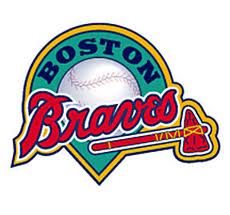Does Knowing the Origin of Native American Team Names Solve Anything?
 Determining the origins of Native American sport team nicknames turns out to be a more complicated matter than I originally assumed.
Determining the origins of Native American sport team nicknames turns out to be a more complicated matter than I originally assumed.
Take, for example, the Cleveland Indians, who are frequently derided for their name and the offensiveness of their symbol, Chief Wahoo. There was an original Cleveland Indian who was actually an Indian, but it is an open question as to whether or not the current team was named in his honor.
From 1887 to 1899, there was a different major league baseball team in Cleveland, and from 1897 to 1899, that team featured an extremely talented Penobscot Indian outfielder named Louis Sockalexis.
This team had no official nickname, though it was most frequently referred to as the Cleveland Spiders (apparently because it had had a large number of tall, spindly players in the early 1890’s).
However, sportswriters occasionally referred to the team by other names, including the Forest Cities and the Blues in the early years, and after the arrival of Sockalexis in 1897, as the Indians, or sometimes as Tebeau’s Indians (Patsy Tebeau was the team’s Irish-American player-manager), and even as Tebeau’s Hibernian Indians.
When the National League folded its Cleveland team after the 1899 season, the Western (soon to be renamed American) League moved its Grand Rapids, Michigan team to Cleveland, and that is the team that plays today as the Cleveland Indians.
Like its predecessor, this team originally had no official nickname but was referred to by various names, including the Lake Shores, the Bluebirds, the Blues, and the Naps (after star player Napoleon Lajoie). Once in a while a sportswriter would revive the name Indians when writing about the team, but such references were infrequent.
In 1915, after the departure of Lajoie, the team decided to officially assume the name Indians. While later accounts of the naming claimed that it was in honor of Sockalexis or the result of a public survey, there is no contemporary evidence to support such claims.
It seems more likely that the Cleveland owners in the winter of 1914-1915 were trying to steal an idea from the Boston National League team.
In December 1911, the Boston Nationals — previously known informally as the Beaneaters — adopted the name Braves. The Braves did more than adopt a name; they were also the first major league team to place a symbol on their uniforms — in their case, an Indian chief head similar to that on the then-current $5 gold piece.
Although Boston had no Indian players, fans appeared to like the new name, and the use of supposedly Indian terminology — like “warpath” and “scalped” — became common in reports of the team’s games. Attendance did go up, and the team’s new ballpark, opened in 1914 (now Boston University’s Nickerson Field), became unofficially known as “The Wigwam.” Improvement on the field went much slower, but in 1914 the “Miracle Braves” were the improbable champions of the National League and the winners of the World Series, even though they had been in last place as late as the Fourth of July.
Apparently, Cleveland chose the name Indians to try to capture something of the aura that surrounded the Braves of Boston that winter and to capitalize of the apparent appeal of the faux Native American linkage.
However, the Indians initially did little to emphasize the connection to Native Americans other than rename the team. The team did not attach an Indian head logo to its uniforms until 1928, and the first version of the infamous Chief Wahoo did not appear until 1946. It also did not print the name Indians on its uniforms until after World War II.
Why Boston chose to adopt the name Braves in December 1911 is also perplexing. The idea clearly came from new co-owner John Montgomery Ward. (Ward, a New York lawyer, had been one of the greatest major league players of the 19th century and is currently a member of the Baseball Hall of Fame.)
Ward’s decision appears to have been influenced by a number of factors. His co-owner James Gaffney was a member of New York City’s Democratic Tammany Hall machine, whose operatives were known jokingly as “braves.” Moreover, the name Braves resonated with Boston’s history thanks to the “braves” who threw the British tea overboard during the Boston Tea Party.
Perhaps most importantly, the month before the name change was announced, the real Indians of the Carlisle Indian School had defeated the Harvard Crimson football team in a game played in Boston (actually Cambridge) that attracted national attention.
In the clash between two undefeated teams, Carlisle, led by star running back Jim Thorpe and tackle William Lonestar Dietz, upset Harvard 18-15 in what was immediately proclaimed as the greatest college football game of all time. Carlisle had jumped off to an early lead, but in the second half Harvard had fought back to tie the game, only to lose on a long field goal booted by a badly hobbled Thorpe.
Thanks to the exploits of the Carlisle football team and the similar success of its baseball team and the nationally known Nebraska Indians baseball team (who regularly won over 100 games each year while travelling across the United States playing the best amateur and semi-pro competition), there was a strong association in the American mind in 1911 between Native Americans and athletic prowess. Carlisle and the Nebraska Indians won, not because of their savagery, but because of their mastery of the fundamentals of sport and their penchant for imaginative, trick plays.
The 1911 Boston National League team had been one of the most pathetic assemblages in major league baseball history, winning only 44 games while losing 107. The team finished an incredible 55 games out of first place and 20.5 games out of seventh (i.e., next-to-last) place while also finishing last in the major leagues in attendance.
That Ward would want to associate athletic prowess and imaginative play with his new team could hardly be a surprise to anyone. Moreover, while the Boston Braves were the first major league team to officially adopt a Native American team name, since the 1880’s, a few minor league and independent professional teams had been nicknamed the “Indians” or occasionally used the names of individual tribes, so the adoption of “Braves” did not seem revolutionary.
What to make of this history? The decision of Boston to call its team the Braves was not exactly disparaging to Native Americans, but it definitely constituted an effort to capitalize on someone else’s cultural “property.”


